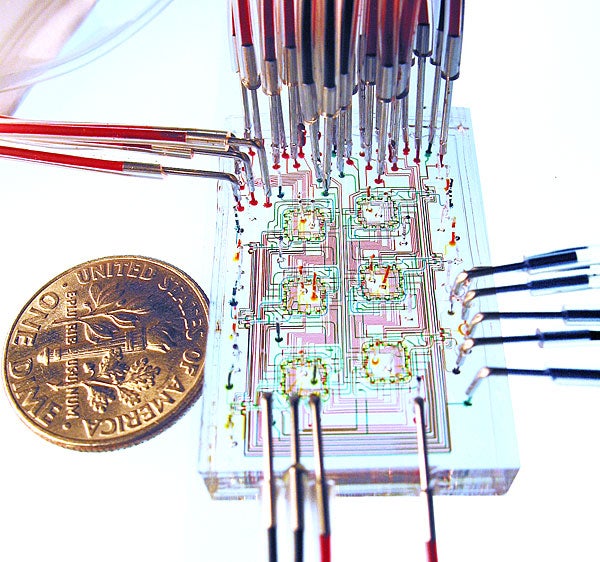Music-Powered Lab-On-A-Chip Promises Easier Health Screening
Engineers harness sound to simplify microfluidic devices (watch the music video!)

Thanks to a new approach to one of microfluidics’ biggest challenges — how do you propel fluid in a number of directions at once without the clutter of myriad electromechanical valves and pumps? — we could be closer to seeing our smartphones double as home flu kits. Credit goes to a team of chemical engineers at the University of Michigan for coming up with the innovative system, which uses music to control the fluid.
It’s a pretty nifty system, and warrants a closer look, but first: a crash course in microfluidics. In the past, lab analysis (of a blood sample, for instance) invariably called for an entire room full of equipment, since lab technicians had no choice but to run each type of test on a different piece of equipment. This method took up space, and time, and required a hefty sample of fluid.
But now, with the advent of microfluidic devices (a.k.a. labs-on-a-chip), the process is much simplified: the necessary lab instruments are all centralized on one tiny silicon chip. This means that you can run several tests at once, and with much less machinery.
Nice — except there’s one kink. To bring about these simultaneous tests, you need to somehow divert the fluid to multiple channels. Up to now, the solution has been to use an assortment of pumps, valves, and electrical connections, wherein each pump controls a specific instance of movement. But this amounts to considerable clutter around the device, and defeats the point of a small-scale microfluidic system.
The new U of M approach, however, doesn’t require any valves and, in fact, only has one external off-chip connection, to sound-amplifying cavities controlled by a computer. When the computer produces a note, the resonance cavities amplify it, producing sound waves that propel the fluid forward.
As engineering whiz Sean Langelier explains, “Each resonance cavity on the device is designed to amplify a specific tone and turn it into a useful pressure. If I play one note, one droplet moves. If I play a three-note chord, three move, and so on. And because the cavities don’t communicate with each other, I can vary the strength of the individual notes within the chords to move a given drop faster or slower.”
[Via LabSpaces.net]
